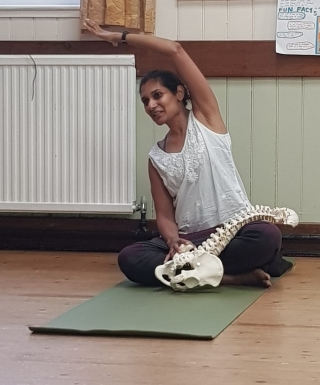In accomplishing these, Yoga is merely a tool. Gone is the reverence for Yoga as a spiritual practice, gone are the links to its roots in Samkhya and Vedanta, gone is the merging of Yoga philosophy and practice. Instead, many classes offer "How to perfect your headstand for greater wellbeing" and other such proclamations.
We can do Yoga while doing a headstand but doing a headstand doesn't mean we are practising Yoga. We can sit cross legged and look at our nose but it doesn't mean we are meditating. Rather, It is when we bring our whole selves, our awareness, intuition and our devotion to the practice, that we are indeed in Yoga.
As teachers, we are all facing this demand to put Yoga to work on behalf of health and wellbeing. Instagram tells us this daily, as do television shows and magazines. There is a great emphasis on being bendy and stretchy, a desire to limber up … and live forever!
But is this what Yoga is? Is this all that remains of Yoga now? Are we in danger of having squeezed all the juice out of the ripe fruit, now left holding the dry rind in our palms? Will that be enough to nourish us?
What happened to the deeper questions? What happened to inquiring gently into a better understanding of our inner landscapes? What happened to our Yoga off the mats, serving others, Seva? What happened to a deeper spiritual quest?
In keeping up with trends, we arrive at a Yoga that is commodified, packaged up and made accountable only to a thirst for longevity and the body beautiful. And what then? When everyone with means is living longer, at what point will we ask the bigger questions? At what point will we speak of death, of letting go, of breaking down the ego (ahamkara), of seeking Sattva (truth) and seeking
stillness (Dhyana and Dharana)?
Are we as teachers at risk of forgetting that meeting point between ourselves and Yoga?
How do we save Yoga from the hype? Can we? Or will we be cancelled and made unviable by the larger market forces? I do think about this even as I pour
myself into each class with deep love and with a desire to share from my heart. I often tell my students that they are my weekly teachers, not me theirs.
As Yoga teachers, we have so much agency and power! We can start coming away from only emphasising postural practice, and bringing to each of our
classes that deeper dialogue about what yoga is at its root. Inner Yoga is not a new set of beliefs that creates another division between the sacred and mundane. It is a cleansing of our eyes within and without, so we can see-truly see-the
sacred all around us.
This then allows us to truly meet Yoga. To truly honour Yoga.
It falls on all of us to be robust in our own understanding and relationship with where we are meeting Yoga.
Tapas is the starting point. The word derives its meaning from the root verb 'tap' which means 'to heat' and it is usually thought of as the cultivation of purifying practices which heat the system and "burn off the dross" (whether that be physical or mental).
From the Katha Upanishad, we learn that it would be easy to take the superficial path of reaction, Preyas, and just do what the market asks of us. However, we also know that the tougher, more reflective path of Shreyas, of pause and responsiveness, is the path which will lead us and our students towards true Yoga. Yoga philosophy is not an adjunct to asana practice-it is the other way around. If we integrate this into every class we teach, we may be able to break this toxic alliance between wellness/fitness demands and modern postural practice.
As teachers, even though we may understand the technical points of a pose, our work does not stop there. Indeed, that is just the starting point. We can take it further, to the breath, to the curious mind, the willingness to be aware without judgement, the strength and the gift, the light and the dark.
I find that by introducing play and humour into each class, by being more collaborative and also more vulnerable, I can widen the container in which we are all held within the shared practice of a Yoga class, workshop or retreat. By bringing a spirit of inquiry to our students, we begin a stronger dialogue. We feel supported when we are seeking something more subtle and nuanced, we create a relationship to our inner being, not just the outer shell, which by default gets enhanced because Yoga has been welcomed within.
Perhaps the best known of the sutras is the second one : ‘Yogas Chitta Vritti Nirodha’ ~ ‘Yoga is the cessation of the fluctuations of the mind’. We can remind ourselves of this sutra before we start each class.
Patanjali goes on to delineate Samadhi (total self-collectedness), Sadhana(spiritual practice and discipline) and Kaivalya (separateness/release/freedom).
Thus, the path of Yoga is towards a state of liberation.
Let's start by liberating our Yoga from the demands of wellbeing, fitness and longevity. And redirect the course towards that light within. Then the self is free to go in search of the Self. And we are established in Yoga.
Find out more about Ami at:
https://www.yogami.biz/
References :
[1] ‘Anywhere Away From Here’ by Pink and Rag and Bone Man
[2] Patanjali’s Yoga Sutras,Chapter 1 Verse 2. Katha Upanishad. Both translations by Swami Ambikananda Saraswati
©Ami Roy, July
2023
